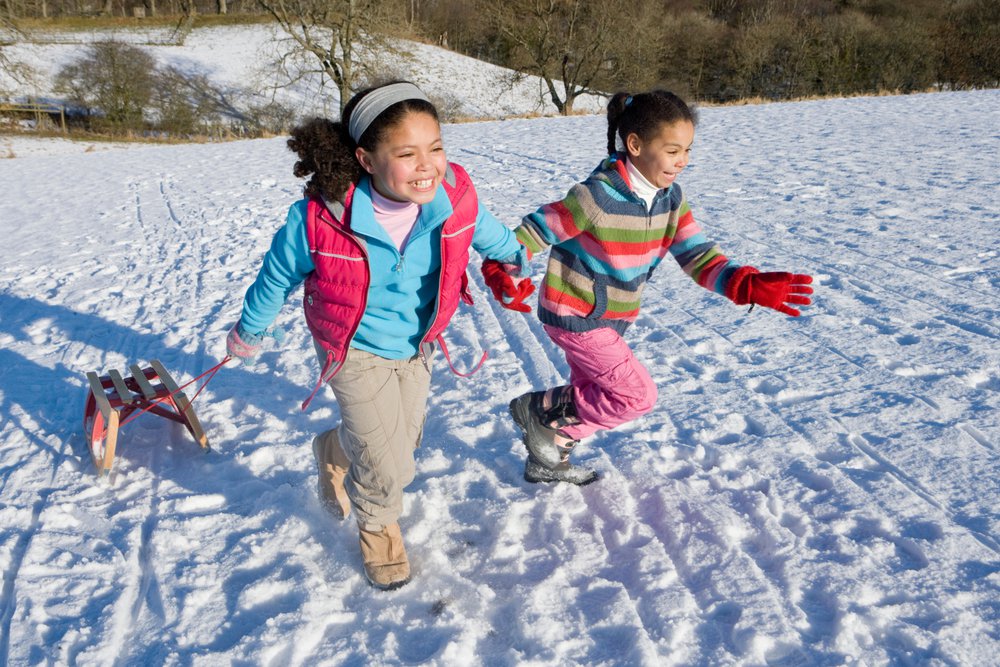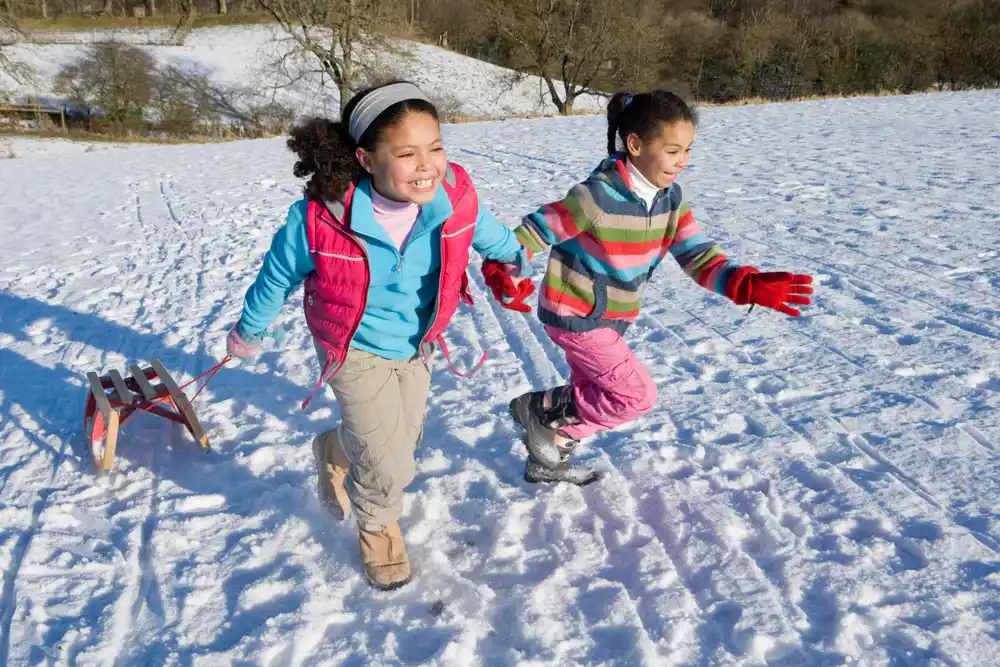 Be Smart About Layering
Be Smart About Layering
Don’t be too conservative with adding layers to your child’s winter outfit, especially if you live in a particularly cold climate. It’s true that our bodies heat up when we’re active outdoors, but it’s better to be able to peel off excess layers than have to go back inside to add more. The general rule of thumb for dressing babies and young children is to add one more layer of clothing on them than an adult would wear in the same conditions.
- Opt for a long-sleeved thermal or woolen undershirt, followed by a sweater or turtleneck, and a warm winter coat for your child’s top-half. It’s best to avoid cotton materials, as they do not provide the best heat insulation.
- For the bottom-half, put on thermal or woolen long underwear first and layer it with a pair of thick pants (such as corduroys), or waterproof pants. Try to avoid jeans, as they are not the best insulators against cold and moisture.
- Make sure they wear heavy or woolen socks with waterproof snow boots on their feet to offer the best protection against the cold, wet snow.
- Last but not least, make sure their head, neck, and hands are well covered. Wool hats provide the most warmth, and styles that tie or button under the chin help ensure they won’t fall off. Tuck an extra pair of mittens or gloves into their coat pocket if your child plans to be outdoors for more than an hour.
Remind Them To Take Breaks
It’s easy for kids to not pay attention to their bodies' signals when they’re having fun in the snow for hours on end. But even just a 4 degree drop in body temperature can have tangible effects on the body, such as shivering, teeth-chattering, a runny nose, weakness and dizziness. Let your child know that if they begin to experience any of these signs, it’s time to take a break. Warm them up with a cup of hot soup or cocoa before they go back outside again.
Drink Plenty of Fluids
Keeping an eye hydration is just as important during the winter as it is during the summer. A lot of moisture inside the body is lost during breathing, and winter activities are sure to require a lot of deep, heavy breaths. Make sure your child has easy access to warm drinks (e.g. herbal tea, hot chocolate) and clear, broth-based soups that will hydrate them while warming them up at the same time.
Prevent Winter Nosebleeds
Heated indoor air dries out the nasal passages, making the blood vessels inside the nose more fragile and likely to rupture. Run a cold-air humidifier and use saline nasal sprays if they are prone to nosebleeds this time of year. The humidifier will put much-needed moisture back into the air, and saline sprays will moisturize their nose.
Practice Winter Sports Safety
Whether you’ve planned a day of snowboarding, ice hockey, or sledding, make sure your child is aware of possible safety concerns with these fun activities.
- Never leave children outdoors without adult supervision.
- Keep a safe distance from roads, highways, and anywhere motor vehicles are present.
- Always sled feet-first or sitting upright, instead of head-first.
- Use a steerable sled; they are much safer than snow tubes and snow discs.
- Sledding hills should have a slope of less than 30 degrees with a flat runoff.
- Helmets and goggles must be worn at all times on skis, snowboards, and sleds.
- Winter sport safety equipment should be fitted to your child every year, and the slopes they practice on must be appropriate for their age and skill level.
- The American Academy of Pediatrics recommends children under the age of 16 should not operate a snowmobile, and children under 6 should never ride on them.
- Ice skate only on approved surfaces--your local police department can tell you which areas have been approved.
- Wear a helmet, elbow pads, and knee pads while ice skating, especially if your child is still a beginner.
Sunscreen Isn’t Just For Summer
Winter sunburns are more common than you may think, particularly among those who play winter sports. According to the American Academy of Dermatology, snow can reflect up to 80 percent of the sun’s UV rays, especially at high altitudes. Always remember to apply an SPF of 15 or higher on your child’s face if they will be outside for an extended period. Don’t forget to apply the sunscreen to the tops of their ears, near their hairline, and around the eyes.
Know The Signs of Frostbite & Hypothermia
Children are at an increased risk of developing cold-weather injuries, including frostbite and frostnip. Have a conversation with your child about paying attention to how their body feels when they’re outside. If they lose sensation in their fingers, toes, cheeks, ears, or nose, it’s time to head inside immediately. Since frostbite numbs the skin, it is not always obvious to people, children or adults, that they are experiencing it.
Frostbite occurs in three increasingly dangerous stages: frostnip, superficial frostbite, and deep frostbite. Frostnip is the mildest form of frostbite, and does not cause any permanent damage to the skin. However, continued exposure to the cold can lead to numbness in the affected area. Superficial frostbite looks like reddened skin that then turns white, and can actually create a burning sensation. With deep frostbite, there is numbness, a loss of function in the joints and muscles, and large blisters that form 24 to 48 hours after rewarming the affected area. The tissue then turns black, hardens, and dies.
Frostbite is a serious medical emergency. Call 911 or go to the nearest urgent care center or emergency room if you suspect that your child has frostbite. While you wait for help to arrive, gently remove all your child’s wet clothing, move them to a warm, dry location, and cover them with blankets.
Hypothermia is a condition that occurs when the body loses heat faster than it can produce it. It can occur after prolonged exposure to the cold, or even at temperatures above 40 degrees Fahrenheit if an individual is submerged in cold weather, or chilled from sweat or rain. Infants and the elderly are the most vulnerable to hypothermia.
Symptoms of hypothermia in babies include bright red, cold skin and very low energy. For children, symptoms include intense shivering, slurred speech, drowsiness, confusion, and loss of coordination. If you notice any of these signs, take your child’s temperature right away. If it is below 95 degrees Fahrenheit, call 911 immediately or go to your nearest urgent care center or emergency room. Before help arrives, follow the same steps as you would for frostbite.
Capital Area Pediatrics offers outstanding, comprehensive pediatric care to families throughout Northern Virginia. We are currently offering telemedicine visits for those who prefer to stay home, as well as touchless check-in to minimize the spread of COVID-19. Our dedicated care team is committed to ensuring the safety and health of children of all ages, from speciality and chronic care services to adolescent health. Request an appointment online or call one of our offices at a location near you.


